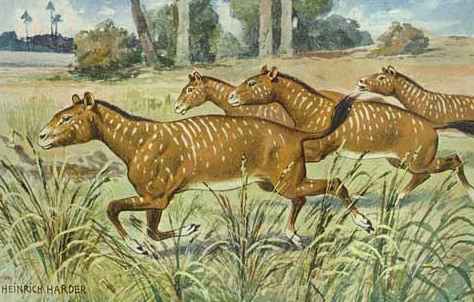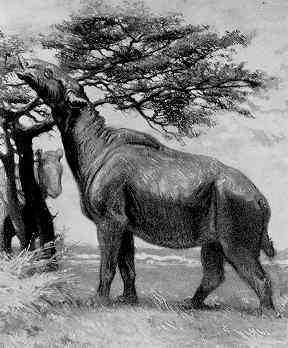| Oligocene Epoch | ||
| Cenozoic: Paleogene Period |
Oligocene |
| Eocene | Cretaceous | Paleogene | ||
| Miocene | Neogene | Rupelian | Time |
|
Paleogene |
|

The Oligocene Epoch (meaning "slightly recent") was the third and youngest division of the Paleogene, and the characterized by an increasing proportion of "modern" animals.
There was an increase in volcanic activity, and plate tectonic movement, as India collided with Asia. The last remnant of the supercontinent of Gondwanaland broke up as Australia and South America both separated from Antarctica
The Oligocene also marked the start of a generalized cooling, with glaciers forming in Antarctica for the first time during the Cenozoic. The increase in ice sheets led to a fall in sea level. The tropics diminished, giving way to cooler woodlands and grasslands. Although there was a slight warming period in the late Oligocene, the overall cooling trend was to continue, culminating in the Ice Ages of the Pleistocene.
By the Oligocene the major evolution and dispersal of modern types of angiosperms had occurred. The vegetation of the higher latitudes in the northern hemisphere changed from an essentially broad-leaved tropical evergreen forest such as had typified the Eocene, to a temperate deciduous woodland of evergreen and broad-leaved trees. This type of woodland is seen today only in certain relict areas like the North Island of New Zealand and the tip of the South African Cape. Grasses, which appeared for the first time as plants of water margins in the Eocene, became more common in open habitats.
In North America the flora consisted of a mixture of subtropical elements, such as cashews and lychee trees, with temperate trees such as roses, beech and pine. Leguminous plants of the pea and bean family were common, as were sedges, bulrushes and a variety of ferns.

In the seas the Nummulitid foraminifera continue with some abundance. The genus Lepidocyclina replaces Orthophragmina. Irregular echinoids such as Scutella and Clypeaster first appear
Following the terminal Eocene extinction which took out the Dinocerata, Archaeoceti, and most of the Titanotheres and creodonts, new kinds of mammals evolved and expanded in an evolutionary radiation of many new types. These included the prehistoric ancestors of dogs, cats, rhinoceroses (including both small slender running types and hippo-like semi-aquatic forms), and horses (such as Mesohippus, above).
But the most important transition among terrestrial mammals involved the artiodactyls (even-toed ungulates) taking over from the perissodactyls as the dominant medium-sized herbivores in the middle Tertiary. These included the most common animals of the period, the sheep-like oreodonts which flourished in huge numbers. Meanwhile the omnivorous niches were filled by giant pig-like entelodonts like Archaeotherium (shoulder height 1 metre), which retained short legs and low-crowned teeth.
While artiodactyls appeared in the late Paleocene, they remained rare, and it was only during the Oligocene that advanced forms (the first camels) developed a rumen, a complex fore-stomach that aids in the digestion of cellulose. This provided these animals with a great advantage in dealing with a fibrous diet, such as was appearing with the vegetation of the time, and would become even more important during the rest of the Cenozoic as the world continued to become drier and cooler.

The largest animals remained - as in the late Eocene - the perissodactyls. The huge hornless rhinos (Indricotherium - weight 15 to 25 tonnes) of central Asia was the largest land mammals ever to live, matching even the great sauropod dinosaurs in size. These enormous beasts continued for some fifteen million years in Asia, surviving until the Mid Miocene
Meanwhile, ancestral elephant-like forms and the rhinoceros-like Arsinoitheres grew to large size in Africa, where the first anthropoid apes appeared as well.
In South America, completely different herbivores evolved, the Edentates (sloths, armadillos, etc), the strange Meridiungulates, and, in view of the absence of placental carnivores, various lines of marsupial predators and the giant flightless flesh-eating Phorusrhacids birds - 1.5 meters and more in height.
Little is known of life in Australia and Antarctica at this time.
Epoch |
Standard Age |
representative animal |
|---|---|---|
|
Oligocene Epoch |
Chattian |
|
|
Rupelian |
|
University of California Museum of Paleontology -- The Oligocene Epoch
The Terrestrial Eocene-Oligocene Transition in North America ed. by Donald R. Prothero and Robert J. Emry.
The Eocene-Oligocene Transition by Donald R. Prothero (The Critical Moments and Perspectives in Paleobiology and Earth History Series).
The Oligocene Bridge Creek Flora of the John Day Formation, Oregon by Herbert W. Meyer, Steven R. Manchester (University of California Publications in Geological Sciences, Vol 141).